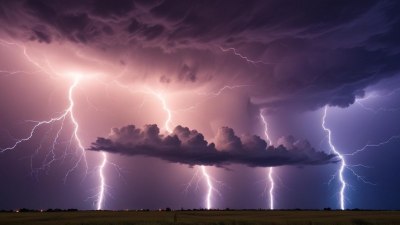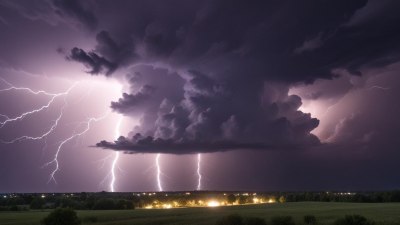Why Some Storms Are More Electrically Active
Explore the science behind the electrical activity in storms and why some are more electrifying than others.

This image was created with the assistance of Freepik
Storms are a fascinating aspect of meteorology, and among their many features, electrical activity stands out with lightning as its most dramatic manifestation. The intensity and frequency of lightning can vary significantly among different storms, prompting scientists and meteorologists to investigate the underlying reasons. This article delves into the elements that contribute to the electrification of storms, highlighting atmospheric conditions, storm types, and geographical influences that play a crucial role in determining how electrically active a storm can become.
The Basics of Storm Formation
Before we unravel the specifics of electrical activity in storms, it's vital to understand how storms form. Storms develop when warm, moist air rises and cools, leading to the condensation of water vapor and the creation of clouds. As these clouds grow, they can develop into various types of storms, including thunderstorms, tornadoes, and hurricanes. The primary drivers of storm formation are temperature, humidity, and atmospheric instability.
Understanding Thunderstorms
Thunderstorms are the most common type of electrified storms and serve as a perfect model for studying lightning activity. These storms typically form when warm, moist air rises rapidly, creating cumulus clouds that can grow into towering cumulonimbus clouds. The vertical movement of air within these clouds is crucial for generating electricity. Updrafts and downdrafts within the cloud create a separation of electrical charges; positive charges accumulate at the top, while negative charges build at the base.
Charge Separation Process
The charge separation process is essential for lightning formation. As the storm develops, collisions between ice particles, hailstones, and supercooled water droplets occur. These collisions lead to the transfer of electrons, allowing the cloud to acquire a significant electrical charge. This process is influenced by the size of ice particles, the temperature, and the speed of the updrafts. The stronger the updrafts, the more significant the charge separation, leading to a higher likelihood of lightning activity.
Factors Influencing Electrification
Several factors influence how electrically active a storm will be, including humidity, temperature gradients, and the presence of natural features like mountains. High humidity levels contribute to the storm's moisture content, essentially fueling thunderstorms. When moisture is abundant, it enhances the updrafts within the storm, increasing electrical activity. Similarly, significant temperature gradients between the surface and the upper atmosphere can result in increased instability, thereby fostering more intense storms.
The Importance of Atmospheric Conditions
The state of the atmosphere plays a vital role in a storm's electrification potential. When the atmosphere is unstable, with warm air at the surface and cooler air aloft, it creates conditions conducive to strong storm development. This instability allows for stronger updrafts that can support more significant charge separation. Additionally, atmospheric pressure systems can influence storm patterns; for example, low-pressure systems often lead to more intense storms and increased lightning activity.
Geographical Factors
Geographic location plays a critical role in the frequency and intensity of electrically active storms. Regions located near large bodies of water, like the Gulf of Mexico, often experience more thunderstorms due to the availability of moisture. Mountains can also induce storm formation as they force air upwards, enhancing updrafts and contributing to charge separation. Areas with lush vegetation, where there is abundant evaporation, can also lead to increased storm activity, as moist air rises and contributes to storm development.
Seasonal Variations
The season can significantly impact the electrical activity of storms. Summer is typically the most active season for thunderstorms due to the combination of warmer temperatures and increased humidity. In contrast, winter storms may be less electrically active due to cooler temperatures and lower humidity levels. However, winter storms can still generate lightning, particularly when warm, moist air from the south interacts with colder air masses. These conditions can lead to a different type of electrical activity that might surprise many.
Impact of Climate Change
Climate change is influencing weather patterns globally, and storms are no exception. As the earth's temperature continues to rise, we can expect changes in storm behavior. Warmer temperatures can lead to increased moisture in the atmosphere, potentially resulting in more frequent and intense thunderstorms. Higher atmospheric temperatures can also lead to greater charge separation, increasing the likelihood of electrical activity within storms. Thus, understanding how climate change impacts storm electrification is an essential area of research.
Technology and Forecasting
Advancements in technology have provided meteorologists with tools to study storm electrification more effectively. Doppler radar systems allow for the monitoring of storm structure, while ground-based lightning detection systems provide real-time data on lightning strikes. These technologies help scientists understand the conditions that contribute to electrical activity in storms better and improve forecasting ability. More accurate forecasts can lead to better preparedness for severe weather events, potentially saving lives and property.
The electrifying nature of storms is a complex interplay of various atmospheric factors, charge separation processes, geographical influences, and seasonal variations. By understanding why some storms are more electrically active than others, we can better prepare for their potential impacts. Continued research into the dynamics of storm electrification will enhance our understanding of severe weather phenomena, especially in a rapidly changing climate. From the science behind thunderstorms to the impact of climate change, the study of electrically active storms offers fascinating insights into the natural processes that shape our environment.











